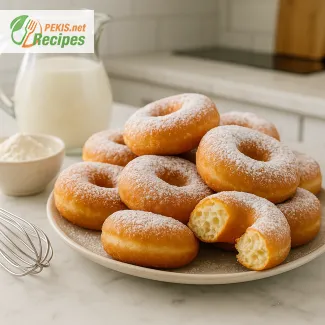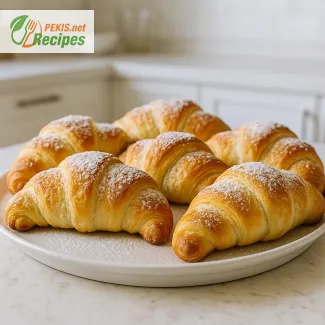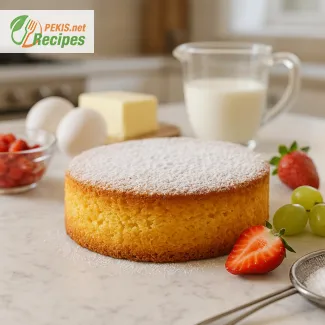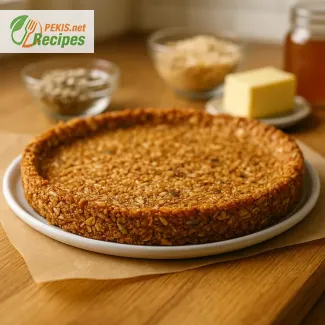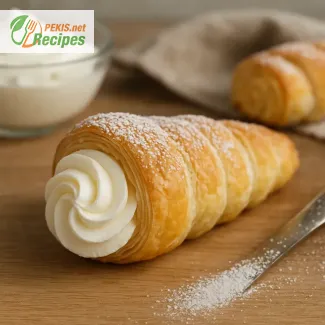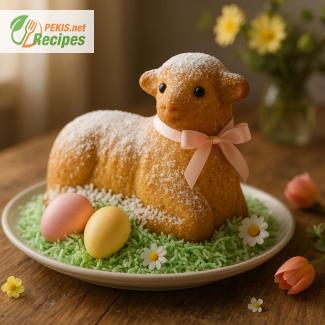
Classic Easter Lamb Cake: A Timeless Springtime Tradition
Discover the charm of a festive centerpiece that’s as delicious as it is beautiful
Among the many symbols of Easter—painted eggs, blooming flowers, and colorful baskets—few are as nostalgically cherished as the Easter lamb cake. This moist, tender sponge cake baked in the shape of a lamb is more than just a dessert; it’s a celebration of heritage, spring renewal, and the joy of gathering around the table. Whether nestled into a bed of green-tinted coconut "grass" or dusted with powdered sugar like a fresh spring snowfall, the lamb cake remains a beloved centerpiece of many Easter traditions, especially in Central and Eastern European households.
The Easter lamb cake dates back generations, with roots in European Christian symbolism, where the lamb represents purity, renewal, and peace. Over the years, this cake has become a culinary staple, lovingly passed down through families, often using a vintage cast-iron mold that has baked its way through countless spring celebrations. Today, even with the modern conveniences of silicone or nonstick molds, the sentiment remains the same: baking an Easter lamb cake is a heartfelt tribute to tradition, creativity, and the sweetness of spring.
What sets this cake apart isn’t just its iconic shape, but its delicate texture and flavor. The best lamb cakes are moist, buttery, and lightly sweet, with just enough structure to hold their form, yet tender enough to melt in your mouth. Many recipes strike a balance between a classic pound cake and a sponge cake, ensuring the final creation is sturdy enough to stand proudly without sacrificing softness. In our version, a touch of vanilla and a hint of citrus zest add a light, refreshing note that perfectly captures the season.
But this cake isn’t just about the flavor—it’s also about the experience. Decorating your lamb cake is an opportunity for fun and family bonding, where kids and adults alike can get involved. A simple dusting of powdered sugar brings elegance, while piped frosting details, edible flowers, or candy eyes can turn it into a whimsical, showstopping centerpiece. Coconut shreds can mimic wool, and a ribbon tied around the neck gives the lamb a festive touch.
The appeal of the Easter lamb cake lies in its versatility and charm. It fits beautifully into a traditional Easter brunch, a formal dinner spread, or a relaxed spring picnic. It also makes a thoughtful homemade gift—wrapped in cellophane and tied with a pastel bow, it brings joy wherever it travels. And for those who honor religious significance, it serves as a meaningful and symbolic addition to the holiday table.
As spring brings with it a sense of renewal and togetherness, this lamb-shaped cake embodies both. It’s a reminder of cherished memories and a way to create new ones. From its golden crust to its tender crumb, from its symbolic form to its decorative flair, the Easter lamb cake is a delightful blend of tradition, taste, and artistry.
Whether you’re continuing a family custom or starting a new tradition of your own, this cake is more than a recipe—it’s a celebration. A moment to pause, to create, to share, and most of all, to enjoy. Let the aroma of freshly baked vanilla cake fill your kitchen and the sight of a sweet little lamb warm your heart this Easter.
Next, we’ll guide you through every step of creating the perfect Easter lamb cake—from ingredients to assembly, baking to decorating—so that your table boasts not just a dessert, but a centerpiece of celebration.
- Prepare the lamb mold: Preheat the oven to 175°C (350°F). Thoroughly grease both halves of a lamb-shaped cake mold with butter and dust with flour. Tap out the excess. If using a two-piece mold, make sure to also grease the inner detailing. Set aside.
- Cream the butter and sugar: In a large mixing bowl, beat the softened butter and granulated sugar together until light and fluffy. This should take about 3–4 minutes with a hand or stand mixer.
- Add the eggs: Add the eggs one at a time, beating well after each addition to fully incorporate.
- Add flavorings: Mix in the vanilla extract and freshly grated lemon zest. The zest adds a bright citrus note that enhances the flavor and freshness of the cake.
- Combine dry ingredients: In a separate bowl, whisk together the all-purpose flour, baking powder, and salt.
- Alternate flour and milk: Add the dry ingredients to the butter mixture in three parts, alternating with the milk. Start and end with the dry ingredients. Mix gently to avoid overbeating.
- Fill the mold: Spoon the batter into the prepared mold, filling it slightly more than halfway to ensure the cake rises and fills the shape. If your mold has a back half, place it carefully on top and secure.
- Bake the cake: Place the filled mold on a baking sheet and bake for about 50–55 minutes. If the mold is in two parts, you may need to remove the back after 45 minutes and allow the front to finish for an additional 10 minutes until golden and a toothpick inserted comes out clean.
- Cool and unmold: Let the cake cool in the mold on a wire rack for 15–20 minutes. Carefully remove the back of the mold, then gently turn out the front onto the rack. Let cool completely before decorating.
- Decorate: Once the cake is fully cooled, dust it with powdered sugar for a classic look, or use whipped cream, frosting, coconut, and candies to create a festive lamb. Tie a ribbon around the neck for a charming finish.
Enhancing Your Easter Lamb Cake: Flavorful Twists and Smart Baking Tips
Creative upgrades and healthier choices for an even better Easter dessert
Baking a traditional Easter lamb cake is a heartwarming experience, filled with history and family memories. Yet even the most time-honored recipes can be reimagined and improved without losing their nostalgic charm. Whether you're looking to boost flavor, improve texture, make it healthier, or simply ensure baking success, a few expert tips and creative adjustments can make a big difference.
Ingredient swaps that enhance flavor and texture
The original lamb cake recipe uses classic ingredients like butter, eggs, sugar, and flour, but small adjustments can elevate both taste and appearance.
Add sour cream or Greek yogurt
For a moister crumb, replace 60 ml (¼ cup) of the milk with full-fat sour cream or Greek yogurt. This not only adds moisture but also a subtle tang that complements the vanilla and lemon zest. The cake becomes softer and more velvety, especially helpful if you're using a mold with intricate details.
Infuse with almond or orange extract
A drop or two of almond extract offers a richer, nutty background flavor, while orange extract can enhance the spring-like freshness of the lemon zest. These subtle variations add complexity without overpowering the original vanilla base.
Swap white sugar for brown sugar or coconut sugar
Using light brown sugar instead of granulated sugar introduces a gentle caramel note and slightly more moisture. For a healthier touch, coconut sugar provides a lower glycemic index and adds a mild toffee flavor.
Use cake flour for a lighter texture
While all-purpose flour is traditional, replacing it with cake flour will create a finer crumb and a more tender structure—especially important for cakes made in detailed molds.
Incorporate citrus glaze instead of powdered sugar
For an elegant finish, drizzle a glaze made with fresh lemon juice and powdered sugar over the lamb after baking. It not only enhances the flavor but also adds a slight shine, making the cake more visually appealing.
Why homemade is always better
Store-bought cakes can never match the richness, freshness, and personal touch of a homemade lamb cake. When baking at home, you control every ingredient, avoiding preservatives, artificial flavors, and excess sugar. This also allows for customization—adjusting sweetness, fat content, or flavor profiles to your liking or dietary needs.
Additionally, baking this cake together with family creates a deeper connection to tradition. Children love helping with decoration, and adults often find joy in revisiting childhood memories. The act of baking becomes part of the holiday itself, not just the meal.
Common mistakes and how to avoid them
Overfilling the mold
This is one of the most frequent problems. If you fill the mold too full, the batter will spill out during baking, creating an uneven or messy result. Always fill the mold only two-thirds full to allow room for rising.
Underbaking or overbaking
Due to the mold’s shape, some parts may bake faster than others. To avoid undercooked centers or burnt edges, consider placing foil around thinner areas during the last 10–15 minutes of baking and always test with a skewer before removing from the oven.
Improper greasing of the mold
Failing to grease every crevice thoroughly can result in the cake sticking and breaking. Use softened butter and a pastry brush to reach every part, then dust with flour and tap out the excess.
Removing the cake too early
Allow the cake to cool in the mold for at least 15–20 minutes before unmolding. Removing it too soon may cause cracking or structural damage, especially in areas like the neck or legs of the lamb.
Healthier alternatives without losing tradition
Even festive desserts can be made healthier without sacrificing flavor. Here are a few smart substitutions:
- Butter alternatives: Use half butter and half unsweetened applesauce or mashed banana for reduced saturated fat and added nutrients.
- Egg replacements: For those avoiding eggs, mix 1 tbsp of ground flaxseed with 3 tbsp of water per egg. This binds the batter and adds omega-3s.
- Whole grain flour: Substitute half of the all-purpose flour with white whole wheat flour to boost fiber while keeping a light texture.
- Reduced sugar: Cut the sugar by 20% and enhance flavor with more vanilla and lemon zest to maintain sweetness perception.
Flavor pairings and decoration ideas
To bring a touch of elegance and modern flair to your Easter table, consider pairing your lamb cake with complementary elements:
- Serve with a side of fruit compote or fresh berries for a refreshing contrast to the sweetness of the cake.
- Add a layer of lemon curd between two halves of the lamb (if split) for a surprise burst of citrus.
- Instead of just powdered sugar, use whipped mascarpone or cream cheese frosting and pipe decorative swirls to mimic wool.
- Garnish the base with edible flowers or sugared herbs like mint for a charming and natural look.
Storage and make-ahead tips
To ensure your lamb cake stays fresh for Easter Sunday:
- Bake the cake 1–2 days in advance, wrap it tightly in plastic wrap once cooled, and store at room temperature.
- If decorated with cream or frosting, store it in the fridge, but allow to come to room temperature before serving to restore softness.
- Freeze undecorated cakes for up to one month; thaw overnight in the fridge and bring to room temp before decorating.
More than just a dessert, the Easter lamb cake symbolizes renewal, joy, and shared tradition. When baked thoughtfully—with care, creativity, and quality ingredients—it becomes a gift of love to everyone at your table. By tweaking the traditional recipe with smart enhancements or health-conscious choices, you not only preserve its legacy but also shape it for generations to come.
- Eggs
- Wheat (gluten)
- Milk (dairy)
Tips for allergen-free adaptation:
- Eggs: Replace each egg with 1 tbsp ground flaxseed mixed with 3 tbsp water (let sit 10 minutes).
- Milk: Use unsweetened almond or oat milk in the same quantity.
- Butter: Substitute with dairy-free margarine or coconut oil.
- Gluten: Use a gluten-free all-purpose flour blend with ½ tsp xanthan gum added for structure.
- Vitamin A: 310 IU – supports vision and immune health
- Vitamin D: 0.5 µg – aids calcium absorption and bone health
- Vitamin B2 (Riboflavin): 0.2 mg – essential for energy metabolism
- Calcium: 40 mg – important for bone strength
- Iron: 1.2 mg – supports oxygen transport in the blood
- Magnesium: 12 mg – aids muscle and nerve function
- Potassium: 85 mg – helps regulate blood pressure
- Vitamin E: 0.6 mg – protects cells from oxidative stress
- Flavonoids (from lemon zest): approx. 10 mg – support heart and brain health
- Beta-carotene (trace from butter): 25 µg – antioxidant and precursor to vitamin A
This traditional Easter lamb cake is not only a beautiful symbol of spring but a moist, flavorful dessert that captures the essence of the season. With its rich history, playful decorating options, and wholesome ingredients, it’s the perfect sweet addition to your Easter celebration—bringing joy, flavor, and tradition to your table.
